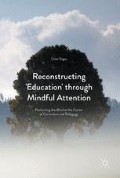Abstract
This chapter begins with William James’s claim ‘for the moment what we attend to is reality’. Based on it we establish attention, space, and time as the fundamentals of mind, which serve as the grounding for the reconstruction of ‘education’. The chapter engages the reader in a series of mindfulness practices, which lead us to develop ‘the matrix of mind’. This matrix grants us with a twofold orientation of attention in space: in here (me) or out there (not-me) and a twofold experience-conception of time: horizontal time axis (past-present-future) or discrete moments of attention (now-now-now). The matrix positions the mind for the reconstruction of ‘education’, defines ‘education’s’ boundaries as a practice of attention, and provides a framework based on which contemporary ‘education’ can be critiqued.
From within this mind-body things do not look quite the same as they do from out there.
Access this chapter
Tax calculation will be finalised at checkout
Purchases are for personal use only
Notes
- 1.
This is no other than the Buddha’s opening verse of The Dhammapada: ‘All phenomena are preceded by the mind, issue forth from the mind, and consist of the mind.’ (Translated in Wallace [1999, p. 176])
- 2.
I am not claiming that what we know is limited to what we are aware of attending. James indeed claimed that, “[T]he sum total of our impressions never enters our experience” (1984, p. 227). Furthermore, Michael Polanyi (1958) proposed that ‘we know more than we can tell’. My claim is that whatever it is that we do know can only be acknowledged as such, based on the fact that we attended to it.
- 3.
- 4.
See Merleau-Ponty (1965) for a far more nuanced phenomenology of this domain, that I intentionally avoid here.
- 5.
For the philosophers among you – I am attempting to stick with epistemology and avoid ontology as best I can.
- 6.
This phrasing is inspired by the great Zen teacher Shunryu Suzuki (1999) who spoke in a similar way about the movement of breath in to our bodies, and then out. The conception of a ‘view’ follows neuroscientist Antonio Damasio’s (2005) reference to the ‘view’ of the body in his discussion of Descartes’ erroneous dualism.
- 7.
Cognitive research and neuroscience reassert this. In fact attending in and out involves two different brain networks – the intrinsic and the extrinsic networks respectively (Golland et al. 2007). These two networks are antagonistic (i.e., when one is activated the activity in the other is reduced) (See also, Raichle et al. 2001).
- 8.
There are actually more conceptions. A third one for example, is the timeless that is occasionally featured in this book as well, and has to do with the ‘reflective/philosopher’s I’ (discussed in chapter 9) that works with abstractions such as Platonic forms.
- 9.
If you are wondering ‘who is doing the threading’ or what exactly is the thread that binds these beads, I share your wonder. This book will not offer answers to questions that I cannot answer. It may, however, provide further paths by which to keep questioning and to seek answers.
- 10.
References
Berkovich-Ohana, A., & Glicksohn, J. (2014). The consciousness state space (CSS)—A unifying model for consciousness and self. Frontiers in Psychology, 5(341), 1–19.
Csikszentmihalyi, M. (1991). Flow: The psychology of optimal experience. New York: HarperPerennial.
Damasio, A. (2005). Descartes’ error: Emotion, reason, and the human brain. London: Penguin.
Golland, Y., Bentin, S., Gelbard, H., Benjamini, Y., Heller, R., Nir, Y., Hasson, U., & Malach, R. (2007) Extrinsic and intrinsic systems in the posterior cortex of the human brain revealed during natural sensory stimulation. Cerebral Cortex, 17(4), 766–777.
Hans, J. S. (1993). The mysteries of attention. Albany, NY: State University of New York Press.
James, W. (1983). Talks to teachers on psychology and to students on some of life’s ideals. Cambridge, MA: Harvard University Press.
James, W. (1984). Psychology, briefer course. Cambridge, MA: Harvard University Press.
James, W. (2007). The principles of psychology. New York, NY: Cosimo.
Langer, E. J. (1997). The power of mindful learning. Reading, MA: Addison-Wesley/Addison Wesley Longman.
Lewin, D. (2014). Behold: Silence and attention in education. Journal of Philosophy of Education, 48(3), 355–369.
Merleau-Ponty, M. (1965). Phenomenology of perception. London: Routledge & Kegan Paul.
Nørretranders, T. (1998). The user illusion: Cutting consciousness down to size. New York: Viking Penguin.
Polanyi, M. (1958). Personal knowledge; towards a post-critical philosophy. Chicago: University of Chicago Press.
Raichle, M. E., MacLeod, A. M., Snyder, A. Z., Powers, W. J., Gusnard, D. A., & Shulman, G. L. (2001). A default mode of brain function. Proceedings of the National Academy of Sciences, 98(2), 676–682.
Suzuki, S. (1999). Zen mind, beginner’s mind (1st rev. ed.). New York: Weatherhill.
Wallace, A. B. (1999). The Buddhist tradition of Samatha: Methods of refining and examining consciousness. Journal of Consciousness Studies, 6(2–3), 175–187.
Weil, S. (1986). Simone Weil, an anthology. New York: Weidenfeld & Nicolson. https://www.amazon.com/Simone-Weil-Anthology/dp/0802137296.
Werner, K. (1996). Effortless mastery: Liberating the master musician within. Albany, NY: Jamey Aebersold Jazz, Inc.
Author information
Authors and Affiliations
Copyright information
© 2017 The Author(s)
About this chapter
Cite this chapter
Ergas, O. (2017). Attention, Space, Time, and ‘Education’. In: Reconstructing 'Education' through Mindful Attention. Palgrave Macmillan, London. https://doi.org/10.1057/978-1-137-58782-4_2
Download citation
DOI: https://doi.org/10.1057/978-1-137-58782-4_2
Published:
Publisher Name: Palgrave Macmillan, London
Print ISBN: 978-1-137-58781-7
Online ISBN: 978-1-137-58782-4
eBook Packages: EducationEducation (R0)

